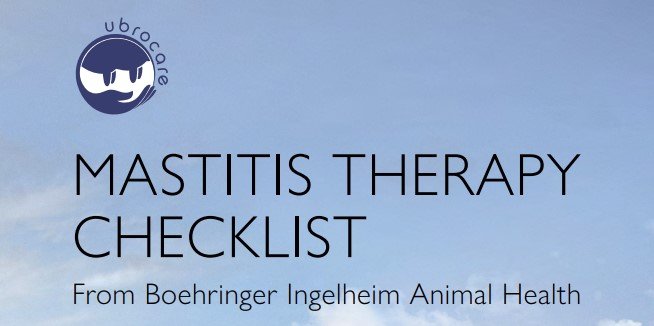Reviewing mastitis treatment protocols
- more than just “which tube?”
To get the best out of mastitis treatments, it’s important for producers to regularly review protocols with their vets. Here we look at how to get the best out of a mastitis treatment review, using Boehringer’s Mastitis Therapy Checklist.

Prevention should always be the main focus, but there will always be cases that require treatment. Boehringer’s Mastitis Therapy Checklist helps vets and producers work together through the various factors that might impact on cure rates and agree on any changes to the protocol.
Firstly, it’s important to establish exactly what is going on. A few difficult-to-treat cases may give the impression that the current protocol isn’t working, but that might not accurately reflect what’s really going on, so it’s vital to take a look at the data. This is where clinical case records are valuable. Ideally these records will be on a farm software system or collected by the milk recorder, but even if they’re just in the farm diary they can be transferred to a spreadsheet for useful analysis. Analysis of basic information (date of mastitis case, cow ID and calving date) can reveal the incidence of new infections, the recurrence rate and whether new infections are predominantly occurring in the dry period or lactation period. Producer and vet can then start making some informed decisions. If the data suggests that cure rates could be improved, the checklist review can help drill down into where gains might be made.
Mastitis detection
Effective mastitis treatment begins with prompt and early detection. Herds that are not forestripping are likely to miss mild cases of mastitis, where clots are present without heat or swelling in the udder. This may not be too much of a problem in herds with good cure rates and low mastitis incidence, but if cure rates are low, time in the parlour spent forestripping cows to detect mastitis early will be a sound investment. This will enable the producer to start treating cases earlier in the course of disease, helping to improve cure rates.
Insertion technique
The next area to check is tube insertion. Much is, rightly, made of good hygiene practices when administering dry-cow therapy – hygiene is just as important when treating mastitis in milking cows. A full teat disinfection protocol using surgical spirit and cotton wool, just as when administering dry-cow therapy, reduces the risk of introducing new pathogens to the udder when inserting milking cow tubes.
For tubes where there’s an option of partial or full removal of the cap to reveal a short or long nozzle, the shorter less invasive nozzle on the tube should be used to reduce the chance of damaging the keratin lining of the teat.1
Frequency of treatment
How often the treatment should be administered will depend on the tube. Some require twice a day treatment and others just once a day. Using a tube that’s licenced for once-a-day treatment means the cow is tubed fewer times for a given treatment duration. This should reduce the chance of introducing infection or damaging the keratin lining of the teat. After infusion, products disperse into the udder tissue, so products licensed for once-a-day use remain at effective levels for 24 hours, even after milking2.
Anti-inflammatory treatment
It’s now widely accepted that an important part of an effective mastitis treatment protocol is administering an anti-inflammatory treatment such as Metacam®. Mastitis is a painful condition – even mild cases are painful. This is a good enough reason alone to provide pain relief, but there’s also evidence to show that using Metacam® alongside antibiotic treatment can improve cure rates3, improve fertility3 and reduce culling4.
Which tube?
The review will help the farm vet decide the most appropriate tube to prescribe depending on the mastitis pattern on the farm. The vet may prescribe a narrow or broad-spectrum treatment, and will consider the licenced duration of treatment amongst other factors, to ensure cases of mastitis are treated with the most appropriate product for the optimal number of days.
Once the treatment protocol has been revised and agreed by producer and vet together, a simple written protocol should be displayed in the parlour.
The Boehringer Mastitis Therapy Checklist is a valuable tool to help producers and their vets take a systematic approach to mastitis treatment reviews.
Speak to your vet for more information.
References
1: Nickerson (1987) Resistance mechanisms of the bovine udder; new implications for mastitis control at the teat end. J Am Vet Med Assoc. Dry Cow Therapy: 1; 191 (11) 1484-8
2. Goutalier et al. (2013) Distribution of cefalexin and kanamycin in the mammary tissue following intramammary administration in lactating cow. J Vet Pharmacol Ther: 36(1):95-8.
3. McDougall et al. (2016) Addition of meloxicam to the treatment of clinical mastitis improves subsequent reproductive performance. J Dairy Sci: 99(3):2026-42.
4. McDougall et al. (2009) Effect of treatment with the nonsteroidal
anti-inflammatory meloxicam on milk production, somatic cell count, probability of retreatment,
and culling of dairy cows with mild clinical mastitis. J Dairy Sci 92: 4421–4431
Metacam® 20 mg/ml solution for injection for cattle, pigs and horses and Metacam 40mg/ml solution for injection for cattle and horses contain Meloxicam. UK: POM-V. Advice should be sought from the prescriber. Further information available in the SPCs or from Boehringer Ingelheim Animal Health UK Ltd, RG12 8YS, UK. Tel: 01344 746957. Email:vetenquiries@boehringer-ingelheim.com. Metacam® is a registered trademark of Boehringer Ingelheim Vetmedica GmbH, used under licence. ©2022 Boehringer Ingelheim Animal Health UK Ltd. All rights reserved. Date of preparation: Oct 2022 BOV-0138-2022. Use Medicines Responsibly.
- 1st November 2022
